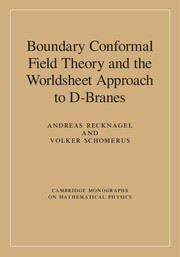Book contents
- Frontmatter
- Dedication
- Contents
- Introduction
- 1 Free field theory with boundaries
- 2 Superstrings and branes
- 3 Conformal field theory on the plane
- 4 Boundary conformal field theory
- 5 Perturbations of boundary conformal field theories
- 6 The Wess–Zumino–Witten model on SU(2)
- 7 Gepner model boundary states and Calabi–Yau branes
- Appendix
- References
- Index
4 - Boundary conformal field theory
Published online by Cambridge University Press: 05 November 2013
- Frontmatter
- Dedication
- Contents
- Introduction
- 1 Free field theory with boundaries
- 2 Superstrings and branes
- 3 Conformal field theory on the plane
- 4 Boundary conformal field theory
- 5 Perturbations of boundary conformal field theories
- 6 The Wess–Zumino–Witten model on SU(2)
- 7 Gepner model boundary states and Calabi–Yau branes
- Appendix
- References
- Index
Summary
In this chapter, we will introduce conformal field theory (CFT) on surfaces with boundaries and lay the technical foundations for the remainder of this text. As with CFT on surfaces without boundary, we can in principle take different approaches to boundary CFT, but from our point of view, and for applications to string theory, the BPZ or “representation theoretic” picture involving Walgebras and operators on Hilbert spaces provides the most effective, explicit and flexible way to tackle boundary conditions in CFT.
The whole subject of boundary CFT was founded by Cardy, who almost single-handedly pushed its development very far. His works [98–100] still provide an excellent introduction, together with papers by Ishibashi [294] and [102, 334] by Cardy and Lewellen. In the late 1980s, Sagnotti realised the potential of boundary CFT for the description of open strings in arbitrary backgrounds [399], and later constructed many models, see, e.g., [53–55, 383, 384, 401], using Cardy's methods as well as additional constraints pertinent to open string theory. The latter are tadpole cancellation conditions involving non-orientable worldsheets – which have to be taken into account in type I string theory, but not necessarily when discussing D-branes. Since those will be our main focus in this book, we will almost everywhere restrict ourselves to orientable worldsheets - and mainly to the lowest genus case, at that: our boundary CFTs will be defined on the disk, on a strip or simply on the upper half-plane.
- Type
- Chapter
- Information
- Publisher: Cambridge University PressPrint publication year: 2013



